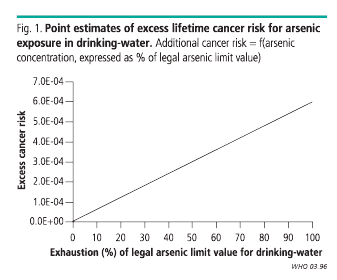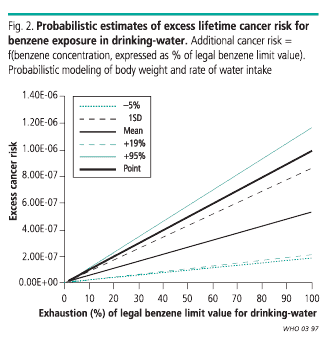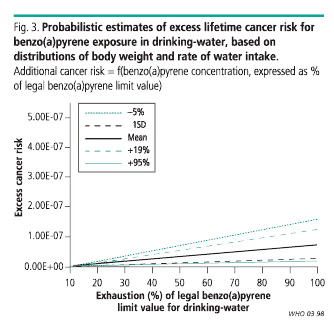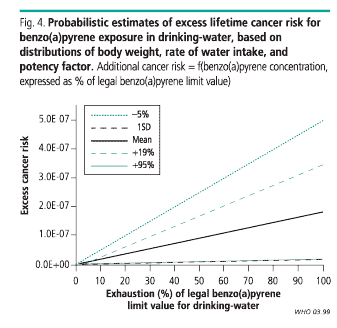POLICY AND PRATICE
Towards health impact assessment of drinking-water privatization the example of waterborne carcinogens in North Rhine-Westphalia (Germany)
Vers une évaluation de l'impact sanitaire de la privatisation de l'eau de boisson l'exemple des substances cancérogènes véhiculées par l'eau dans l'Etat de Nord-Rhin-Westphalie (Allemagne)
Hacia la evaluación del impacto sanitario de la privatización del agua potable ejemplo de los carcinógenos presentes en el agua en Renania del Norte-Westfalia (Alemania)
Rainer FehrI,1; Odile MekelI; Martin LacombeI; Ulrike WolfII
IInstitute of Public Health (loegd) North Rhine-Westphalia, Westerfeldstr. 35-37, 33611 Bielefeld, Germany. (email: rainer.fehr@loegd.nrw.de)
IIUniversity of Bielefeld, Bielefeld, Germany
ABSTRACT
Worldwide there is a tendency towards deregulation in many policy sectors this, for example, includes liberalization and privatization of drinking-water management. However, concerns about the negative impacts this might have on human health call for prospective health impact assessment (HIA) on the management of drinking-water. On the basis of an established generic 10-step HIA procedure and on risk assessment methodology, this paper aims to produce quantitative estimates concerning health effects from increased exposure to carcinogens in drinking-water. Using data from North Rhine-Westphalia in Germany, probabilistic estimates of excess lifetime cancer risk, as well as estimates of additional cases of cancer from increased carcinogen exposure levels are presented. The results show how exposure to contaminants that are strictly within current limits could increase cancer risks and case-loads substantially. On the basis of the current analysis, we suggest that with uniform increases in pollutant levels, a single chemical (arsenic) is responsible for a large fraction of expected additional risk. The study also illustrates the uncertainty involved in predicting the health impacts of changes in water quality. Future analysis should include additional carcinogens, non-cancer risks including those due to microbial contamination, and the impacts of system failures and of illegal action, which may be increasingly likely to occur under changed management arrangements. If, in spite of concerns, water is privatized, it is particularly important to provide adequate surveillance of water quality.
Keywords: Potable water/supply and distribution; Water supply; Privatization; Environmental health; Environmental monitoring/methods; Risk assessment; Carcinogens, Environmental; Water pollutants, Chemical/toxicity; Arsenic/toxicity; Germany (source: MeSH, NLM).
RÉSUMÉ
On observe actuellement dans le monde entier une tendance à la déréglementation dans de nombreux secteurs relevant de la compétence des pouvoirs publics cela comprend, par exemple, la libéralisation et la privatisation de la gestion de l'eau de boisson. Toutefois, les préoccupations qui se font jour concernant les effets négatifs que cette évolution risque d'avoir sur la santé humaine justifient de réaliser des analyses prospectives concernant l'impact sanitaire de la gestion de l'eau de boisson. En s'appuyant sur une procédure d'analyse incrémentale classique en dix étapes fondées sur des augmentations progressives des concentrations de polluants et sur une méthode d'évaluation des risques, le présent article vise à fournir des estimations quantitatives des effets sur la santé résultant d'une exposition accrue à des substances cancérogènes contenues dans l'eau de boisson. A partir de données recueillies pour l'Etat de Nord-Rhin-Westphalie en Allemagne, des estimations de probabilité sont présentées concernant l'accroissement du risque de cancer pendant la durée de vie et le nombre additionnel de cas de cancer qui pourrait découler de l'exposition à des niveaux accrus de substances cancérogènes. Les résultats montrent comment l'exposition à des contaminants qui restent strictement dans les limites actuellement admises peuvent accroître notablement les risques de cancer et le nombre de cas. Sur la base de cette analyse, il apparaît que pour un accroissement uniforme des niveaux de polluants, un seul produit chimique (l'arsenic) serait responsable d'une part importante du risque additionnel attendu. Cette étude illustre aussi l'incertitude qui entoure toute prévision des répercussions sanitaires des changements de la qualité de l'eau. Les futures analyses devraient couvrir un plus grand nombre de substances cancérogènes et prendre en compte des risques autres que le cancer, y compris ceux dus à la contamination microbienne et aux conséquences de défaillances éventuelles du système ou d'actes illégaux qui ont davantage de chances de se produire avec la modification des modes de gestion. Si, en dépit des préoccupations exprimées, l'eau est privatisée, il est particulièrement important d'assurer une surveillance adéquate de sa qualité.
Mots clés: Eau potable/ressources et distribution; Alimentation eau; Privatisation; Hygiène environnement; Surveillance environnement/méthodes; Evaluation risque; Cancérogènes, Environnement; Polluants chimiques eau/toxicité; Arsenic/toxicité; Allemagne (source: MeSH, INSERM).
RESUMEN
Se observa en todo el mundo una tendencia a la desregulación en muchos sectores de política, lo que incluye por ejemplo la liberalización y privatización de la administración del agua potable. Ahora bien, la preocupación por los efectos perjudiciales que ello pudiera acarrear para la salud humana obliga a hacer una evaluación prospectiva del impacto sanitario (EIS) de la gestión del agua potable. Basándose en un procedimiento genérico y comprobado de EIS en 10 pasos y en los métodos de evaluación de riesgos, este artículo tiene por objeto aportar estimaciones cuantitativas de los efectos sanitarios del aumento de la exposición a carcinógenos en el agua potable. Utilizando los datos correspondientes a Renania del Norte-Westfalia, Alemania, se presentan estimaciones probabilísticas del exceso de riesgo de cáncer a lo largo de la vida, así como estimaciones de los casos adicionales de cáncer debidos al aumento de la exposición a carcinógenos. Los resultados indican que la exposición a contaminantes que se encuentran de hecho dentro de los límites en vigor podría dar lugar a aumentos sustanciales del riesgo de cáncer y del número de casos. Sobre la base de los actuales análisis, sugerimos que, en un contexto de aumento uniforme de los niveles de contaminantes, un solo producto químico (el arsénico) es responsable de una gran proporción del riesgo adicional previsto. El estudio ilustra también la incertidumbre inherente a la predicción del impacto sanitario de las variaciones de la calidad del agua. Los futuros análisis deberían abarcar otros carcinógenos, riesgos distintos del cáncer, incluidos los asociados a la contaminación microbiana, y las repercusiones de los fallos de los sistemas y de las actividades ilegales, que tienden a ocurrir con mayor frecuencia cuando se instauran nuevos mecanismos de ordenación del agua. Si pese a esos motivos de preocupación el agua se privatiza, es muy importante asegurar una vigilancia adecuada de su calidad.
Palabras clave: Agua potable/provisión y distribución; Abastecimiento de agua; Privatización; Salud ambiental; Monitoreo del ambiente/métodos; Medición de riesgo; Carcinógenos ambientales; Contaminantes químicos del agua/toxicidad; Arsénico/toxicidad; Alemania (fuente: DeCS, BIREME).


Introduction
Drinking-water is one of the oldest public health issues and is associated with a multitude of health-related concerns. These concerns are comprehensively presented in WHO's Guidelines for drinking-water quality (14). Both microbial and chemical contaminants for example, metals, by-products of disinfection, chlorinated solvents, pesticides, and hormonally active chemicals need to be considered. People become exposed to contaminants via ingestion (drinking-water, food prepared using drinking-water), inhalation (vapours from showering, bathing, cooking, washing), and dermal absorption (showering, bathing, washing). Outbreaks of gastrointestinal illness, leukaemia from disinfection by-products, spontaneous abortion, cancer, and childhood liver cirrhosis are prominent among proven or suspected water-related diseases.
Internationally, the role of potable water for human health is acknowledged in a multitude of programmatic and technical documents, including the legally binding water protocol of the London Ministerial Conference on Environment and Health. The Council of the European Commission adopted a revised directive on the quality of water intended for human consumption (5), and the United Nations proclaimed 2003 as the International Year of Freshwater (6). In Germany over the past few years, several high-ranking committees, including the Office of Technology Assessment (7), the federal government's Scientific Advisory Board on Global Change (8), and the federal government's Environmental Council (9), have addressed the issue of providing safe drinking-water.
In most countries worldwide, there is a strong tendency towards deregulation and privatization in many policy sectors. This includes liberalization and privatization of the management of drinking-water. The debate on expected or possible health outcomes of such changes in management has been mostly in qualitative terms (10). The British Medical Association analysed the situation in the United Kingdom after privatization of the water industry, and expressed concern that disconnections from water supplies may put the health of household members and local communities at risk (11).
The possibility of privatizing drinking-water on a large scale calls for a prospective analysis of the consequences for human health. For such situations, the approach of health impact assessment (HIA) has been developed, as documented, for example, in 1997 and 1999 WHO conferences (12, 13) or in a German national HIA workshop in 2001 (14). Health impacts can be assessed both within and outside traditional environmental impact assessments (EIA), and on both project level and strategic level, the latter referring to the impact assessment of policies, plans, and programmes.
The present paper investigates the expected health impacts of a hypothetical change in water management from predominantly public to largely private. Following the rationale of HIA, the objective is to apply existing scientific knowledge in a useful way. The objective is not to produce new results. More specifically, on the basis of established HIA procedure and risk assessment methodology, this paper aims to provide quantitative estimates concerning health effects from increased exposures to carcinogens in drinking-water.
Motivation for this analysis derived from the mission of the State Institute of Public Health North Rhine-Westphalia; the responsibilities of the Institute include analysing current and potential future threats to human health. The results of the present analysis, however, can be equally applied to similar developments in other regions of the world.
Data and methods
Data used in this analysis refer to the state of North Rhine-Westphalia. The assessment is based on an established, generic 10-step approach of HIA (15, 16), including status quo analysis and prediction of exposures and health effects (Table 1). The procedural approach was originally developed for project level HIA and is now being explored for strategic HIA. The core methodology applied here is quantitative risk assessment (17), including the following components: hazard identification, exposure assessment, doseresponse assessment, and risk characterization. Hazard identification implies that a decision has to be made on which agents to include in the risk assessment. Our analysis is restricted to carcinogens. Several recognized carcinogens can be found in drinking-water (Table 2), and our analysis is based on six such carcinogens chosen on the basis of regulation by European and German legislation and on the basis of data availability.

The exposure assessment is based on variables of human physiology and water quality. Body weight and rate of water intake are used as physiological measures. The point estimates are 60 kg and 2.0 l/day for body weight and rate of water intake, respectively (1). For the probabilistic part of the modelling, both variables enter the model as probability density functions. On the basis of seven age groups, body weight follows a unimodal distribution with a mean value of 61 kg (SD 8.3 kg) (18). Water intake is modelled by a lognormal distribution with a mean of 1.108 (SD 0.631) l/day (19). We distinguish between current quality and scenarios of decreased quality. For current quality, we use observed or estimated concentrations of selected chemicals. If current values are below the analytical thresholds (detection limits), then, as customary, we use 50% of the detection limits as estimates of current concentrations. For each chemical, we model the potentially decreasing water quality by increments of 10% of the respective legal maximum limit values.
For doseresponse assessment, we use potency factors, as is customary for non-threshold agents that have the oral route as the pathway to exposure. Here, the potency factors are derived from WHO guideline values for drinking-water (1, 4). These values are based on the assumption of a daily intake of 2 l of drinking-water by a person weighing 60 kg. For carcinogenic pollutants, guideline values are set in such a way that the excess lifetime cancer risk is 1 in 105, except for arsenic (60 in 105). From this, we derive potency factors with units (mg/kg/day) 1. Such potency factors are estimates of upper limits (95th percentiles). To explore the uncertainty involved in the doseresponse assessment, we also use potency factors from two other sources for benzo[a]pyrene (BaP) as one selected parameter. These sources are the Dutch National Institute for Public Health and Environment (RIVM) (20) and the United States Environmental Protection Agency (US-EPA) (21), where the potency factors originate from an approach comparable to the WHO source.
In this present paper, the risk characterization follows four different approaches. First, point estimates of excess cumulative lifetime cancer risk caused by higher exposure to carcinogens are derived directly from the potency factors. Second, probabilistic equivalents of these point estimates are derived by using probability density functions instead of point estimates. In the first step, the exposure parameters of body weight and water intake are treated this way; the second step also includes the potency factor. Third, relative risks for increased versus current exposure levels are computed, dividing increased risks by current risks. Fourth, additional cases of cancer from increased exposure to carcinogen are estimated by multiplying excess risks with population sizes.
Results
In terms of the generic HIA approach applied here, the privatization of drinking-water provision is the broader topic under study. Summarizing the results (Table 1) of a topic analysis in this study (HIA step 1), the economic arrangement of services and utilities is now widely acknowledged as having the potential for pronounced implications on the mode and performance of operations. In the United Kingdom, the privatization of water provision was associated with an increase in household disconnections, which the British Medical Association saw as a threat to human health and well-being (11). So, water privatization can be interpreted as being a measure of economic policy, installed with the intention to minimize expenses while obeying legal constraints. Currently in Germany and in most other highly industrialized countries, the quality of drinking-water far exceeds the legal requirements. However, to achieve this quality, often a considerable amount of effort and resources has to be spent. Commercial water providers might find it unfeasible or unnecessary to overfulfil legal requirements.
The current analysis covers the region (HIA step 2) of North Rhine-Westphalia, which has a population (HIA step 3) of 18 million. For this exploratory analysis, background levels of contaminants (HIA step 4) are derived from the drinking-water surveillance system of North Rhine-Westphalia. For environmental changes (HIA step 5), the study focuses on the potential deterioration in drinking-water quality, which is analysed for each carcinogen in steps of 10% increase towards the respective limit values.
Exposures and health effects (HIA step 6) are estimated using standard methodology of quantitative risk assessment for non-threshold agents. In terms of hazard identification, the analysis is currently based on six carcinogens often found in drinking-water: benzene; 1,2-dichloroethane; arsenic; benzo(a)pyrene; methane trichloride; and bromodichloromethane. Acrylamide and vinyl chloride are also carcinogenic substances that are regulated by European and German law, but because of a lack of surveillance data they are excluded from further analyses. According to the International Agency of Research on Cancer (22) and the Commission "Maximum Allowable Workplace Concentrations" (MAK) of the German Research Consortium (23), these agents are recognized carcinogens with a proven or suspected carcinogenic effect on humans (Table 2). WHO guideline values (1, 4) and EU limit values (8) for these agents are shown in the same table. Within the risk assessment methodology, exposure assessment and doseresponse assessment were conducted as described above. The results of the four different approaches of risk characterization are given below.
Point estimates of excess lifetime cancer risk
With point estimates of body weight and rate of water intake, the excess lifetime cancer risk is estimated by a simple linear function. Taking arsenic as an example, for levels of around 30% of the legal limit value (10 mg/l), the excess risk is slightly below 2 in 10 000 (Fig. 1).

Probabilistic estimates of excess lifetime cancer risk
Considering the variability of body weight and rate of water intake, the result for each level of exhaustion of the limit value is itself represented by a probability density function, conveniently described by percentiles. Taking benzene as an example, for levels around 30% of the legal limit value, the 95th percentile of the distribution is about 3.5 per 10 million, and the 5th percentile is about 0.5 per 10 million (Fig. 2). For the example of benzo(a)pyrene (B(a)P), we start again with probabilistic modelling of body weight and rate of water intake. Here, the 95th percentile of excess risk at a concentration of 30% of the limit value is about 5 per 100 million (Fig. 3). When we take the probabilistic modelling one step further and also include the potency factor, then for B(a)P levels of 30% of the limit value, the 95th percentile of excess lifetime cancer risk is about 15 per 100 million (Fig. 4).



Relative risks of cancer for increased versus current carcinogen exposure levels
For the six carcinogens mentioned above, the estimated cancer risks for increased levels of exposure to carcinogen are compared with cancer risks from estimated current levels of exposure. The drinking-water surveillance system of North Rhine-Westphalia showed that current exposure levels are far below the limit values and, moreover, often below the detection limits. For all substances therefore, concentration levels were estimated to be half of the detection limits. Resulting relative risks are shown for the scenarios of 10%, 20%, 30%, and 100% exhaustion of limit values, with "10% exhaustion" meaning that the modelled concentration is 10% of the legal maximum limit value. For the 100% scenario, the resulting relative risks, depending on current exposure levels, vary between 6 and 100 (Table 3).

Estimated additional cases of cancer from increased levels of exposure to carcinogen
Focusing on the scenarios of 10%, 30%, and 100% exhaustion of limit values, the potential additional cases of cancer are computed for two populations. One of these illustrates a "typical" water provider serving 1.2 million inhabitants, and the other one equals the population of the state of North Rhine-Westphalia. In this modelling analysis of excess cancer risk, the contribution of arsenic far outweighs the combined contribution of all other carcinogens (Table 4).

Conclusions
The study reported in this paper was motivated from recent trends towards privatization and liberalization of water management. Wherever the management of water changes from predominantly public to largely private, the question of expected impacts on health arises. On the basis of established HIA procedure and risk assessment methodology, we presented some quantitative estimates concerning health effects from increased exposure to carcinogens. As stated, following the rationale of HIA, the study objective was not to generate new knowledge but to apply existing knowledge in a useful way.
In the state of North Rhine-Westphalia, city and county health departments observe the quality of local water; the information collected is fed into a central database in order to give values for the whole state. According to this surveillance system, water quality in the public supply system is much higher than that required by law. This is largely due to the fact that water companies take great efforts to minimize levels of pollution, which is a costly exercise. It is easily conceivable that, at least in the longer term, water companies working on a commercial basis would allow higher pollutant levels, as long as these levels stay within legal boundaries.
The results of the risk assessment show how exposure to contaminants in drinking-water, with levels that are strictly within current limit values, could substantially increase cancer risks and caseloads. The underlying assumption is that carcinogenic agents have a doseresponse relationship with no threshold; for agents with a threshold, the legal maximum limit values are set in such a way that fulfilment of the regulations should be sufficient to protect the population. Even small or moderate increases in carcinogen levels in drinking-water (exhaustion of 10% or 30% of the limit values) would lead to noticeable increases in cancer risk. For the 30% scenario, relative risk estimates reach values up to 30.
On the basis of this current analysis, with uniform increases in pollutant levels, a single chemical (arsenic) is responsible for nearly 99% of expected additional risk. This is because arsenic has a relatively high potency factor, and the limit value is also relatively high. This limit value is a provisional guideline value, set at a practicable quantification limit level. (The fraction of 99% attributable to arsenic also applies, of course, to the background levels of water pollution.) Nevertheless, the fraction attributed to arsenic may change if the modelling is done more comprehensively. If the contribution of arsenic to overall cancer risk is confirmed, the legal maximum limit value of arsenic would seem to require re-evaluation.
The estimates presented here are the results of straightforward modelling exercises. The strict linearity shown in the figures, therefore, is not an empirical result but reflects a basic model assumption. Notably, the two exposure variables are modelled in a probabilistic way because they are known to vary in the study populations; for the doseresponse relationship the rationale for probabilistic modelling is based not on variation but on uncertainty about the "true" value.
This study has several limitations. The modelling assumptions imply that all concentration levels increase to the same exhaustion level of limit values simultaneously, and that individual cancer risks can be added to total cancer risk. Both assumptions will lead to an overestimation of the effects. Also, the assumption of no threshold may overestimate the effects. However, there may be underestimation. The exposure routes via inhalation (showering, which is relevant for volatile compounds like benzene) and skin uptake (showering and bathing) are not considered here. Other reasons for potential underestimation include the non-inclusion of additional carcinogens; non-cancer risks including risks due to microbial contamination; and the impacts of system failures and of illegal action, which may be increasingly likely to happen under changed management arrangements.
The privatization of water provision may have a variety of impacts, and it needs to be viewed in association with other factors, including long-term trends of groundwater quality, legal regulations and enforcement, surveillance, etc. In the authors' view, major potential consequences of privatization include a tendency towards merely adhering to existing limit values rather than making (costly) efforts towards minimizing pollutants, and a higher risk of accidents that cause pollution of the water supply, with subsequent impairments in water quality.
Obviously, the privatization of water supplies could have an impact on health in several other ways. As mentioned above, in the United Kingdom water privatization has been accompanied by concerns about the ability of customers to pay for supplies, and the subsequent disconnections from the service that this might entail. Such disconnections could have a substantial impact on health for example, in gastrointestinal disease, as reported by the British Medical Association (11). In addition, the social stigma of being unable to pay might have an impact on well-being. To weigh the relative importance of such factors, however, is beyond the scope of this paper. Water privatization might also be associated with benefits, such as an intensified networking of providers, implying a minimum downtime of water provision.
This paper aims to provide a quantitative estimate concerning the potential impact of privatization and liberalization of water management. Currently, we do not know the probability of lowering operational standards. It is not unreasonable to assume that commercially oriented water management may find reasons to avoid costly measures that are not required by law. However, there may also be reasons that lead private water management to maintain high levels of quality for example, for competition. This study especially illustrates the uncertainty involved in predicting the health impacts of changes in water quality.
The German Federal Environmental Agency (24) summarized the debate in the following headline: "Liberalization of water supply in Germany bears risks Federal Environmental Agency sees high standards in health and environmental protection jeopardized". In spite of critical discussion and also in spite of mixed experiences of privatization in other sectors such as rail transport, schools, and energy provision, it is possible that water privatization will proceed. If so, it will be even more important to provide adequate surveillance of water quality. Such surveillance can not, of course, prevent legal limit values being exhausted. It may then trigger a debate if a deterioration in the quality of drinking-water is acceptable to society. 
Conflicts of interest: none declared.
References
1. World Health Organization. Guidelines for drinking-water quality. Vol. 1, Recommendations. 2nd ed. Geneva, 1993.
2. World Health Organization. Guidelines for drinking-water quality. Vol. 2, Health criteria and other supporting information. 2nd ed. Geneva, 1996.
3. World Health Organization. Guidelines for drinking-water quality. Vol. 3, Surveillance and control of community supplies. 2nd ed. Geneva, 1997.
4. World Health Organization. Guidelines for drinking-water quality. Addendum to Vol. 2, Health criteria and other supporting information. 2nd ed. Geneva, 1998.
5. Council of the European Union. Council directive 98/83/EC of 3 November 1998 on the quality of water intended for human consumption. Official Journal of the European Community 5.12.98;L330/32-54.
6. UNESCO (2002). 2003 International Year of Freshwater. Available from: URL: www.unesco.org/water/iyfw2/ (accessed 31 December 2002).
7. Meyer, R, Jörissen, J, Socher, M. Technikfolgen-Abschätzung Grundwasserschutz und Wasserversorgung, Bd. 1 und 2 [Technology Assessment Ground water protection and water provision, vol. 1 and 2]. Berlin: Erich Schmidt; 1995. In German.
8. Wissenschaftlicher Beirat der Bundesregierung Globale Umweltveränderungen. Welt im Wandel Wege zu einem nachhaltigen Umgang mit Süßwasser [Changing world pathways towards sustainable freshwater management]. Berlin: Springer; 1997. In German.
9. Rat von Sachverständigen für Umweltfragen. Flächendeckend wirksamer Grundwasserschutz. Ein Schritt zur dauerhaft umweltgerechten Entwicklung [Countrywide efficient protection of ground water. A step towards sustainable development]. Stuttgart: Metzler-Poeschel; 1998. In German.
10. Brackemann H, Epperlein K, Grohmann A, Höring H, Kühleis C, Lell O, et al. Liberalisierung der deutschen Wasserversorgung. Auswirkungen auf den Gesundheits- und Umweltschutz [Liberalization of the German water provision. Impacts on health and environmental protection]. Umweltbundesamt, Reihe Texte Nr 2/00; 2000. In German.
11. Board of Science and Education. Water a vital resource. London: British Medical Association; 1994:23.
12. Pastides H. Methods for Health Impact Assessment in Environmental and Occupational Health. A selection of papers presented at a consultation sponsored by the World Health Organization and the International Labour Office, Geneva, Switzerland, 911 July, 1997. Epidemiology 1999;10: 569-660.
13. Diwan V, Douglas M, Karlberg I, Lehto J, Magnusson G, Ritsatakis A, editors. Health Impact Assessment: from theory to practice. Report on the Leo Kaprio workshop. Göteborg, 2830 October, 1999. WHO Europe, Nordic School of Public Health, NHV-Report; 2000:9.
14. Welteke R., Fehr R. (editors). Workshop Gesundheitsverträglichkeitsprüfung Health Impact Assessment, Berlin, 1920 November 2001. Landesinstitut für den Öffentlichen Gesundheitsdienst NRW, Bielefeld; 2002. In German.
15. Kobusch A-B, Fehr R, Serwe H-J, editors. Gesundheitsverträglichkeitsprüfung: Grundlagen, Konzepte, Praxiserfahrungen [Health Impact Assessment. Basics, concepts, practical examples]. Baden-Baden: Nomos Verlagsgesellschaft; 1997. In German.
16. Fehr R. Environmental Health Impact Assessment: Evaluation of a ten-step model. Epidemiology 1999;10:618-25.
17. National Research Council. Risk assessment in the Federal Government, Managing the process. Washington DC: National Academy Press; 1983.
18. Ausschuss für Umwelthygiene, editor. Standards zur Expositionsabschätzung [Standards for exposure assessment]. Hamburg: Behörde für Arbeit, Gesundheit und Soziales Hamburg; 1995. In German.
19. Roseberry AM, Burmaster DE. Lognormal distributions for water intake by children and adults. Risk Analysis 1992;12:99-104.
20. Slooff W, Janus JA, Matthijsen AJCM, Montizaan GK, Ros JPM. Integrated criteria document PAHs. RIVM report 758474011. Bilthoven, the Netherlands: National Institute of Public Health and the Environment (RIVM); 1989.
21. U.S. Environmental Protection Agency (2003). IRIS Integrated Risk Information System. Benzo[a]pyrene (BaP). Available from:URL: http://www.epa.gov/iris/subst/0136.htm (accessed 7 January 2003).
22. International Agency for Research on Cancer. IARC Monographs on the evaluation of carcinogenic risks to humans. Vol. 1-82. Lyon, France: WHO/IARC; 1972ff.
23. Deutsche Forschungsgemeinschaft, Senatskommission zur Prüfung gesundheitsschädlicher Arbeitsstoffe. Gesundheitsschädliche Arbeitsstoffe. Toxikologisch-arbeitsmedizinische Begründungen von MAK-Werten [German Research Consortium Commission on evaluation of occupational toxicants: Occupational toxicants. Toxicological and occupational evaluation for MAK values]. Weinheim: Wiley-VCH; 1999. In German.
24. Umweltbundesamt (2000). Liberalization of water supply in Germany bears risks. Press release 44/00. Available from: URL:www.umweltbundesamt.de/uba-info-presse-e/presse-informationen-e/p4400e.htm, accessed on 3 January 2003.
1 Correspondence should be addressed to Dr Rehr at this address
